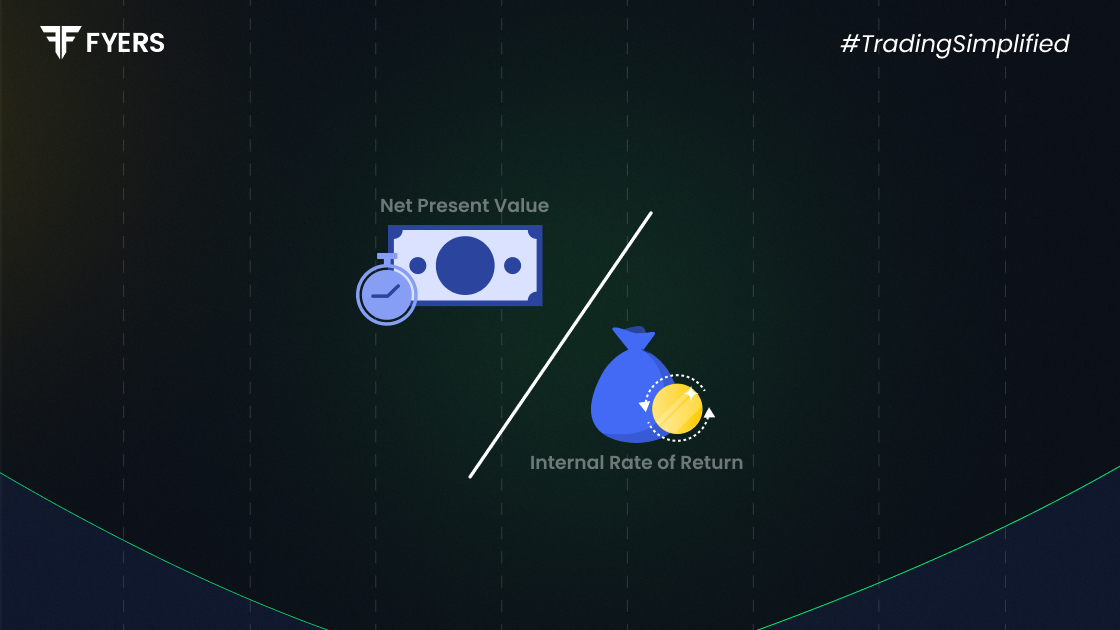

 31 Mar, 2025
31 Mar, 2025
 3 mins read
3 mins read

When you're making investment decisions, understanding financial metrics is crucial. Two of the most important metrics you'll encounter are Net Present Value (NPV) and Internal Rate of Return (IRR). These tools help you evaluate the potential of an investment, but they work differently. In this article, we will understand what NPV and IRR are, how to calculate NPV and IRR, and the advantages and disadvantages of NPV vs IRR.
Net Present Value is a powerful financial tool that helps you understand the true value of an investment.
Imagine you're looking at a potential business opportunity in India. Net Present Value (NPV) evaluates the profitability of an investment by comparing the current value of monetary inflows against the current value of monetary expenditures across a defined timeframe. It takes into account the time value of money, which means it recognises that a rupee today is worth more than a rupee in the future.
For instance, if you're considering investing in a new manufacturing unit in Maharashtra, NPV will help you understand the project's actual financial potential. A positive NPV means the investment is expected to generate value, while a negative NPV suggests the project might not be financially viable.
Internal Rate of Return is another critical metric that helps you evaluate investment opportunities. Think of IRR as the percentage return an investment is expected to generate.
It's the discount rate that makes the NPV of all cash flows equal to zero. In simpler terms, it tells you the annual growth rate you can expect from your investment.
When you're exploring investment options in sectors like technology, real estate, or manufacturing in India, IRR provides a quick way to compare different opportunities. IRR provides insight into an investment's potential attractiveness, with higher percentages suggesting a more promising financial opportunity.
|
Characteristic |
Net Present Value (NPV) |
Internal Rate of Return (IRR) |
|---|---|---|
|
Definition |
The difference between the present value of cash inflows and outflows |
The discount rate that makes the NPV of all cash flows equal to zero |
|
Unit of Measure |
Absolute monetary value (₹) |
Percentage (%) |
|
What it Shows |
Total value created by the investment |
Efficiency or yield of an investment |
|
Decision Rule |
Accept if NPV > 0 |
Accept if IRR > required rate of return |
|
Reinvestment Assumption |
Cash flows reinvested at the discount rate |
Cash flows reinvested at the IRR itself |
|
Multiple Investment Comparison |
Shows magnitude of returns |
Doesn't account for investment size |
|
Sensitivity to Timing |
Accounts for time value with fixed discount rate |
Highly sensitive to timing of cash flows |
|
Multiple IRR Problem |
Not applicable |
Can have multiple values for non-conventional cash flows |
|
Best Used For |
Determining absolute wealth creation |
Comparing investment efficiency |
|
In Indian Startup Context |
Shows actual value creation in rupees |
Shows percentage returns, useful for comparing against other opportunities |
Calculating NPV involves several steps. You'll need to:
Estimate future cash flows
Determine an appropriate discount rate
Calculate the present value of each cash flow
Sum up these present values
Subtract the initial investment
IRR calculation is more complex. It requires finding the discount rate that makes the NPV zero. Most financial professionals use spreadsheet software or financial calculators to perform these calculations accurately.
NPV has several advantages. It considers the time value of money and provides a clear monetary value. However, it requires an accurate estimation of future cash flows and an appropriate discount rate.
IRR is great for comparing different investment opportunities. It gives a percentage return that's easy to understand. However it can be misleading with unconventional cash flows or when comparing projects of different sizes.
In the Indian market, where economic conditions can be dynamic, understanding these nuances is crucial. You'll want to use both NPV and IRR together to make more informed investment decisions.
The primary difference is in how they present investment potential. NPV shows the absolute value creation in monetary terms, while IRR provides a percentage return rate. Think of NPV as telling you how much money you'll make, and IRR as showing the rate of return.
NPV is often considered more reliable because it provides a clear monetary value and accounts for the cost of capital. It doesn't assume reinvestment at the same rate and gives a more straightforward view of an investment's potential value.
Both methods have limitations. NPV requires accurate future cash flow predictions and an appropriate discount rate. IRR can be misleading with multiple or unconventional cash flows.
Calculate your Net P&L after deducting all the charges like Tax, Brokerage, etc.
Find your required margin.
Calculate the average price you paid for a stock and determine your total cost.
Estimate your investment growth. Calculate potential returns on one-time investments.
Forecast your investment returns. Understand potential growth with regular contributions.